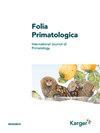在马达加斯加Tsinjoarivo的完整和退化的森林栖息地中,有顶狐猴(diadema Propithecus diadema)表现出很高的繁殖成功率,没有证据表明牙齿衰老或降雨影响生殖产量
IF 0.8
4区 生物学
Q2 ZOOLOGY
引用次数: 0
摘要
Sifakas(Propithecus属)在应对马达加斯加高度季节性气候和最大限度地提高繁殖成功率的策略上与其他狐猴不同:它们寿命长(可能是为了等待不利时期),牙齿极度早熟(让断奶的狐猴能够有效地处理艰难的食物,从而缓解母亲的能量压力)。然而,随着sifakas年龄的增长,牙齿衰老会导致生殖失败,尤其是在与不利的天气条件相结合的情况下(如King等人,2005年Ranomafana的P.edwardsi所示)。为了延长牙齿的有效寿命,补偿刀片保持雌性sifaka的功能,但在某些气候情况下,磨损最终可能会影响婴儿的生存。我们研究了气候、年龄和牙齿衰老对马达加斯加Tsinjoarivo支离破碎的栖息地中另一种小蠊(Propithecus diadema)繁殖的影响。我们记录了2002年至2017年间12个群体的出生和婴儿存活率,其中包括73名新生儿,我们使用了代表54名成年人的77个牙模来估计确切年龄时的年龄。我们报告称,Tsinjoarivo的sifakas不符合将高龄与牙齿和生殖衰老联系起来的预期。与同类动物相比,Tsinjoarivo的diadema Propithecus表现出较慢的牙齿磨损、较高的繁殖能力和较高的婴儿存活率。出生和婴儿死亡的可能性与内在(母亲的年龄、牙齿磨损)或外在(降雨或栖息地类型)压力源无关。然而,没有出生或婴儿死亡的年份很少,这限制了统计能力。在地方一级,这项研究表明,即使在营养摄入减少的扰动片段中,Tsinjoarivo的diadema Propithecus的长期生存能力也很有希望,繁殖产量也很高。需要进行进一步的研究,以了解马达加斯加境内不同地点和地区之间的这些差异,并避免从单个研究地点过度概括。本文章由计算机程序翻译,如有差异,请以英文原文为准。
Diademed sifakas (Propithecus diadema) in intact and degraded forest habitat at Tsinjoarivo, Madagascar, show high reproductive success and no evidence that dental senescence or rainfall affects reproductive output
Sifakas (genus Propithecus) diverge from other lemurs in their strategy to contend with Madagascar’s highly seasonal climate and maximize reproductive success: they have long lifetimes (presumably to wait out unfavorable times) and extreme dental precocity (to allow weanlings to effectively process tough foods and thereby relieve energetic stress on mothers). However, as sifakas age, dental senescence can contribute to reproductive failure, especially when coupled with unfavorable weather conditions (as shown by King et al., 2005 for P. edwardsi at Ranomafana). To extend the effective life of the teeth, compensatory blades maintain functionality for the female sifaka, but wear may eventually have consequences on infant survival in certain climatic scenarios. We investigate the impacts of climate, age, and dental senescence on the reproduction of another sifaka, Propithecus diadema, in fragmented and intact habitats of Tsinjoarivo, Madagascar. We documented birth and infant survival between 2002 and 2017 across twelve groups, including 73 births, and we used 77 dental casts representing 54 adults to estimate age when exact age was not known. We report that sifakas in Tsinjoarivo do not conform to the expectations that link advanced age with dental and reproductive senescence. Propithecus diadema at Tsinjoarivo show slower tooth wear, higher reproductive output and higher infant survival compared to congeners. Likelihood of birth and infant mortality do not correlate with intrinsic (mother’s age, tooth wear) or extrinsic (rainfall or habitat type) stressors. However, the small number of years without births or with infant deaths limits statistical power. At the local level, this study suggests that the long-term viability of Propithecus diadema at Tsinjoarivo is promising and reproductive output is high, even in disturbed fragments where nutrient intakes are reduced. Further research is needed to contextualize and understand these differences among sites and regions within Madagascar and avoid over-generalizing from single study sites.
求助全文
通过发布文献求助,成功后即可免费获取论文全文。
去求助
来源期刊

Folia Primatologica
生物-动物学
CiteScore
3.30
自引率
10.50%
发文量
36
审稿时长
>12 weeks
期刊介绍:
Recognizing that research in human biology must be founded on a comparative knowledge of our closest relatives, this journal is the natural scientist''s ideal means of access to the best of current primate research. ''Folia Primatologica'' covers fields as diverse as molecular biology and social behaviour, and features articles on ecology, conservation, palaeontology, systematics and functional anatomy. In-depth articles and invited reviews are contributed by the world’s leading primatologists. In addition, special issues provide rapid peer-reviewed publication of conference proceedings. ''Folia Primatologica'' is one of the top-rated primatology publications and is acknowledged worldwide as a high-impact core journal for primatologists, zoologists and anthropologists.
 求助内容:
求助内容: 应助结果提醒方式:
应助结果提醒方式:


